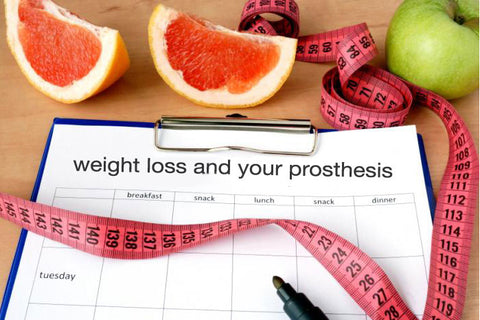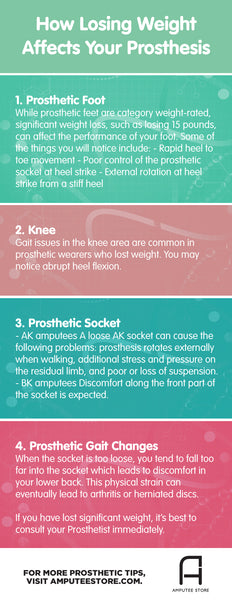How Losing Weight Affects Your Prosthesis
Gaining and losing weight is normal. The body is constantly changing size. This is because our bodies are designed to be dynamic—a response to internal and external factors, such as changing medications and aging. The weather can also be a factor in gaining and losing weight. Summer is around the corner and most people loose weight from increased outdoor activity and less heavy summer foods.
While human bodies are dynamic, prosthetics for the most part aren’t.
So much time and care goes into ensuring that the socket is exactly the right size and dimension so that it integrates seamlessly with the residual limb and the rest of the body.
When fitting a prosthetic device, several visits to your Prosthetist are needed to address unique anatomical considerations. During these visits, your Prosthetist can correct alignment, relieve pressure areas, and tighten or loosen the prosthesis, among others.
Despite this elaborate process, you are not exempt from experiencing issues related to natural fluctuations in body size. Weight issues can arise in certain situations, from being an expecting amputee mommy to eating poorly from a high stress job to any type of surgery when swelling and inflammation are expected. Each of these situations can result in an ill-fitting prosthesis. If this is left unchecked for too long, your prosthesis can cause serious discomfort and a whole host of related complications.
While weight gain presents a specific set of problems, in this article, we will focus on weight loss and its own list of complications.
Gradual weight loss can be remedied with prosthetic supplies, such as thicker gel liners or adding another ply of prosthetic sock. But if you lost a significant amount of weight, your prosthesis can cause discomfort, including friction, a change in gait, and unnecessary physical strain.
Furthermore, if weight loss is not addressed properly and immediately, it can lead to poor control of the prosthesis, increasing your chance of injuring yourself from a fall.

So, what can you do?
First, let’s take a look at what issues you can expect from your prosthesis when you lose weight:
1. Prosthetic Foot
As your Prosthetist may have already explained to you, prosthetic feet are category weight rated. This means that your prosthesis is designed to accommodate mild changes in weight, but a significant weight loss can present problems. It’s good to keep in mind that a prosthetic leg can become less accommodating and rigid after losing 15 pounds.
Here are some of the most common issues related to how your prosthetic foot may feel if you lose a significant amount of weight:
-
Rapid heel to toe movement
You will discover that your knee has a tendency to flex when you try and load the heel. This is because your prosthetic heel is less forgiving when you've lost weight. Essentially your prosthesis is more rigid and as such will progress more quickly from heel contact to late stance phase of walking.
-
Poor control of the prosthetic socket at heel strike
If you wear a prosthetic foot that has been weight rated for a heavier version of you, your limb can rotate within the socket, which leads to poor control of your prosthesis.
-
External rotation at heel strike from a stiff heel
A foot that is effectively categorized for a heavier person can rotate from a stiff heel. This issue is expected when compressing the heel is more difficult because you weigh less and drive less force into the heel at initial contact of walking.
In addition to these three items, you may also notice that you can’t feel the energy return from the heel and toe spring of your carbon or fiberglass foot. This happens because you no longer weigh enough to properly load the foot plate.
2. Knee
Gait issues in the knee area are common for prosthetic wearers who lost weight. If this is you, you may notice inadvertent knee buckling from a stiff heel, which causes abrupt knee flexion, depending on how much weight is lost. When you naturally drive weight into your heel, it's so stiff that it creates a "moment" that causes your knee to buckle, forcing it into flexion.
3. Prosthetic Socket
Above-Knee (AK)
Visiting your Prosthetist immediately helps you prevent serious injuries caused by a loose AK socket. When you lose a significant amount of weight, you want to prevent your prosthesis from rotating externally, especially when you’re trying to control your prosthesis to walk.
Another area where you can feel the effects of losing weight is in your pubic ramus or the bone in your groin area. Losing weight causes your residual limb to dip too far into your socket and begin riding on the socket brim. This adds unnecessary pressure and physical stress.
The same goes for the bottom of your femur bone. In this case, a loose socket can promote pressure either on the side or direct bottom of the bone.
You may also experience poor or loss of suspension. This makes it harder for you to keep your prosthesis on. But if the weight loss is mild, this can be easily remedied with an AK suspension belt or depending on your setup or more prosthetic socks.
Below-Knee (BK)
If you wear your prosthesis below the knee, some issues you can expect include discomfort along the front part of your socket. Pressure along the cut end of the tibia and over your knee cap are other possible issues to watch out for.
4. Prosthetic Gait Changes
Weight loss can greatly affect your gait. Changes happen when the socket is too loose for your residual limb; you tend to fall too far into the socket which leads to discomfort in your lower back. You're essentially walking on a prosthetic limb that is too short. And when you walk in this unnatural position for too long, you put undue physical strain on your body which can manifest in different ways down the road, such as a herniated disc or arthritis.
When you have lost weight, one thing you have to watch out for is the sensation of walking up a hill when you bring your weight over the prosthesis. This is a tell-tale sign that your foot is no longer weight rated appropriately.
If you have a Below-Knee Amputation (BKA) or Above-Knee Amputation (AKA), losing weight makes your prosthesis too short for your residual limb. This leads to a “shoulder dip”, which is evident primarily on your prosthetic side shoulder. Walking with a slight side lean over your prosthetic side is also known as a lateral trunk bend during stance.
Meanwhile, Above -Knee (AK) amputees may experience discomfort along the inner brim of their sockets. If this is you, you may find yourself walking inefficiently with a really wide base of support. Please tell your Prosthetist, before this walking habit becomes more ingrained.
5. Your Options
Now that you have a better understanding of how weight loss can affect your prosthesis, it’s time to explore your options.
According to O&PCare.org, if you experience any change that impacts your limb, contact your Prosthetist immediately to have your prosthesis re-evaluated for a better fit. It’s imperative that they check if your prosthetic foot is still in the correct weight category and recommend whether you need a new prosthesis or just a foot bumper change or a wedge modification.
While waiting for your appointment, you can alleviate discomfort by putting on additional sock ply to tighten the socket. Another option is to add calibrate gel pads, which work well to compensate for socket looseness. They also can alleviate discomfort by preventing either the tibia or femur bone from hitting the wall of the socket.
Another option is a gel roll-on, which can improve the fit of most prosthetic suspension liners. You can add a gel roll-on to most prosthetic designs to seriously tighten the lower half of your socket and lessen friction.
Switching your usual prosthetic liner for a thicker one, say 3mm to 6mm or 6mm to 9mm, can reduce your sock ply count by 10-12 ply.
Now if the socket is loose in different areas, this may warrant more than one product to tighten it, and adding a distal end pad is a great option. This gel end pad is great if your residual limb has lost length and works well with other prosthetic products like socks, gel liners, sheaths, and calibrate gel pads.
In situations like this, it’s also important to take better care of your skin. A skin care regimen helps minimize or prevent friction, which saves you from further discomfort. Consider including a Tamarack liner patch and a Prosthetic Salve in your skincare kit. These products are known for providing on-the-spot relief to your skin.
While the solutions above are Prosthetist approved ways to alleviate discomfort, please keep in mind that these are as temporary as a band-aid. Setting up an appointment with your Prosthetist is still the best way to deal with weight loss and avoid further health issues.
If you have any questions or if you want to share any solutions that have effectively relieved any discomfort caused by weight loss, please leave a comment below. The amputee community wants to know!











































































